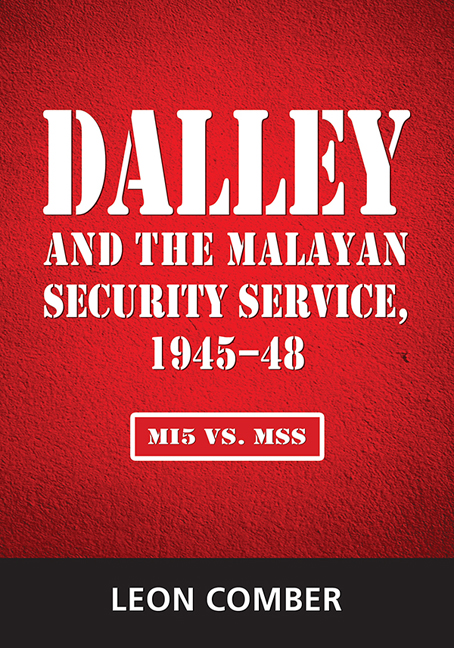Book contents
- Frontmatter
- Contents
- Preface
- Acknowledgements
- List of Abbreviations
- 1 Lieutenant Colonel John Dalley and the MSS: Early Days
- 2 Lieutenant Colonel John Dalley and Dalforce
- 3 The Establishment of “Security Intelligence Far East (SIFE)” in Singapore
- 4 Dalley's Return to Singapore
- 5 The Indonesian Situation and Malaya
- 6 Indonesian Encroachment into Malaya
- 7 Arrangements for Allocation of MSS Staff to Special Branch, Singapore, and Special Branch, Malaya
- 8 Conclusion
- Appendices
- Bibliography
- Index
- About the Author
2 - Lieutenant Colonel John Dalley and Dalforce
Published online by Cambridge University Press: 12 February 2019
- Frontmatter
- Contents
- Preface
- Acknowledgements
- List of Abbreviations
- 1 Lieutenant Colonel John Dalley and the MSS: Early Days
- 2 Lieutenant Colonel John Dalley and Dalforce
- 3 The Establishment of “Security Intelligence Far East (SIFE)” in Singapore
- 4 Dalley's Return to Singapore
- 5 The Indonesian Situation and Malaya
- 6 Indonesian Encroachment into Malaya
- 7 Arrangements for Allocation of MSS Staff to Special Branch, Singapore, and Special Branch, Malaya
- 8 Conclusion
- Appendices
- Bibliography
- Index
- About the Author
Summary
Planning for the military administration of Malaya and Singapore after the Japanese Occupation (1942–45) had actually commenced in London from as early as 1943 by the War Office and the Colonial Office. It was during this period that the decision was made to re-establish post-WWII the pan-Malayan Security Service (MSS) that had existed for a brief period before the Japanese invasion of Malaya in December 1941, and the MSS accordingly returned to Singapore with the British Military Administration (BMA) in September 1945 and remained in place when the civil government returned in April 1946.
Immediate Post-war Situation in Singapore
There were difficulties in operating in the troubled and uncertain times that prevailed in Singapore and Malaya in those early days. Singapore was gripped with lawlessness and violence as soon as the Japanese army withdrew to its barracks, and the situation was not helped by the hiatus of several weeks which ensued before the reoccupying British forces landed in Singapore/ Malaya. During this period the Malayan Communist Party (MCP) and its jungle army, the Malayan People's Anti-Japanese Army (MPAJA), Chinese secret societies, and other armed gangs of civilians emerged to take the law into their own hands. It was a virtual “open house” for them in many ways as the rule of the gun prevailed, and first priority had to be given by the returning British colonial forces to restoring public confidence and combating the crime wave by putting police patrols on the streets supported by British troops.
The delay was probably due to some extent to the unexpectedness of the Japanese surrender and the American General Douglas MacArthur in Tokyo requesting Admiral Lord Louis Mountbatten, the British Commander-in-Chief Southeast Asia, based in Kandy, Ceylon, to postpone accepting the surrender of the Japanese forces in Southeast Asia until the Japanese Government and its armed forces, under the authority of the Japanese Emperor, had signed the official surrender documents on the American battleship USS Missouri in Tokyo Bay.
Return of the Malayan Security Service (MSS)
When the MSS landed in Singapore with the British Military Administration in 1945, the head of the MSS Singapore Division was Major J.C. Barry, and his counterpart in Kuala Lumpur was Lieutenant Colonel J.M. McLean. Both were pre-war Malayan Special Branch officers.
- Type
- Chapter
- Information
- Dalley and the Malayan Security Service, 1945–48 , pp. 13 - 34Publisher: ISEAS–Yusof Ishak InstitutePrint publication year: 2018

